Wenqi Ren
UAGLNet: Uncertainty-Aggregated Global-Local Fusion Network with Cooperative CNN-Transformer for Building Extraction
Dec 15, 2025Abstract:Building extraction from remote sensing images is a challenging task due to the complex structure variations of the buildings. Existing methods employ convolutional or self-attention blocks to capture the multi-scale features in the segmentation models, while the inherent gap of the feature pyramids and insufficient global-local feature integration leads to inaccurate, ambiguous extraction results. To address this issue, in this paper, we present an Uncertainty-Aggregated Global-Local Fusion Network (UAGLNet), which is capable to exploit high-quality global-local visual semantics under the guidance of uncertainty modeling. Specifically, we propose a novel cooperative encoder, which adopts hybrid CNN and transformer layers at different stages to capture the local and global visual semantics, respectively. An intermediate cooperative interaction block (CIB) is designed to narrow the gap between the local and global features when the network becomes deeper. Afterwards, we propose a Global-Local Fusion (GLF) module to complementarily fuse the global and local representations. Moreover, to mitigate the segmentation ambiguity in uncertain regions, we propose an Uncertainty-Aggregated Decoder (UAD) to explicitly estimate the pixel-wise uncertainty to enhance the segmentation accuracy. Extensive experiments demonstrate that our method achieves superior performance to other state-of-the-art methods. Our code is available at https://github.com/Dstate/UAGLNet
SFP: Real-World Scene Recovery Using Spatial and Frequency Priors
Dec 09, 2025Abstract:Scene recovery serves as a critical task for various computer vision applications. Existing methods typically rely on a single prior, which is inherently insufficient to handle multiple degradations, or employ complex network architectures trained on synthetic data, which suffer from poor generalization for diverse real-world scenarios. In this paper, we propose Spatial and Frequency Priors (SFP) for real-world scene recovery. In the spatial domain, we observe that the inverse of the degraded image exhibits a projection along its spectral direction that resembles the scene transmission. Leveraging this spatial prior, the transmission map is estimated to recover the scene from scattering degradation. In the frequency domain, a mask is constructed for adaptive frequency enhancement, with two parameters estimated using our proposed novel priors. Specifically, one prior assumes that the mean intensity of the degraded image's direct current (DC) components across three channels in the frequency domain closely approximates that of each channel in the clear image. The second prior is based on the observation that, for clear images, the magnitude of low radial frequencies below 0.001 constitutes approximately 1% of the total spectrum. Finally, we design a weighted fusion strategy to integrate spatial-domain restoration, frequency-domain enhancement, and salient features from the input image, yielding the final recovered result. Extensive evaluations demonstrate the effectiveness and superiority of our proposed SFP for scene recovery under various degradation conditions.
4KDehazeFlow: Ultra-High-Definition Image Dehazing via Flow Matching
Nov 12, 2025Abstract:Ultra-High-Definition (UHD) image dehazing faces challenges such as limited scene adaptability in prior-based methods and high computational complexity with color distortion in deep learning approaches. To address these issues, we propose 4KDehazeFlow, a novel method based on Flow Matching and the Haze-Aware vector field. This method models the dehazing process as a progressive optimization of continuous vector field flow, providing efficient data-driven adaptive nonlinear color transformation for high-quality dehazing. Specifically, our method has the following advantages: 1) 4KDehazeFlow is a general method compatible with various deep learning networks, without relying on any specific network architecture. 2) We propose a learnable 3D lookup table (LUT) that encodes haze transformation parameters into a compact 3D mapping matrix, enabling efficient inference through precomputed mappings. 3) We utilize a fourth-order Runge-Kutta (RK4) ordinary differential equation (ODE) solver to stably solve the dehazing flow field through an accurate step-by-step iterative method, effectively suppressing artifacts. Extensive experiments show that 4KDehazeFlow exceeds seven state-of-the-art methods. It delivers a 2dB PSNR increase and better performance in dense haze and color fidelity.
DidSee: Diffusion-Based Depth Completion for Material-Agnostic Robotic Perception and Manipulation
Jun 26, 2025Abstract:Commercial RGB-D cameras often produce noisy, incomplete depth maps for non-Lambertian objects. Traditional depth completion methods struggle to generalize due to the limited diversity and scale of training data. Recent advances exploit visual priors from pre-trained text-to-image diffusion models to enhance generalization in dense prediction tasks. However, we find that biases arising from training-inference mismatches in the vanilla diffusion framework significantly impair depth completion performance. Additionally, the lack of distinct visual features in non-Lambertian regions further hinders precise prediction. To address these issues, we propose \textbf{DidSee}, a diffusion-based framework for depth completion on non-Lambertian objects. First, we integrate a rescaled noise scheduler enforcing a zero terminal signal-to-noise ratio to eliminate signal leakage bias. Second, we devise a noise-agnostic single-step training formulation to alleviate error accumulation caused by exposure bias and optimize the model with a task-specific loss. Finally, we incorporate a semantic enhancer that enables joint depth completion and semantic segmentation, distinguishing objects from backgrounds and yielding precise, fine-grained depth maps. DidSee achieves state-of-the-art performance on multiple benchmarks, demonstrates robust real-world generalization, and effectively improves downstream tasks such as category-level pose estimation and robotic grasping.Project page: https://wenzhoulyu.github.io/DidSee/
Adaptive Blind Super-Resolution Network for Spatial-Specific and Spatial-Agnostic Degradations
Jun 09, 2025Abstract:Prior methodologies have disregarded the diversities among distinct degradation types during image reconstruction, employing a uniform network model to handle multiple deteriorations. Nevertheless, we discover that prevalent degradation modalities, including sampling, blurring, and noise, can be roughly categorized into two classes. We classify the first class as spatial-agnostic dominant degradations, less affected by regional changes in image space, such as downsampling and noise degradation. The second class degradation type is intimately associated with the spatial position of the image, such as blurring, and we identify them as spatial-specific dominant degradations. We introduce a dynamic filter network integrating global and local branches to address these two degradation types. This network can greatly alleviate the practical degradation problem. Specifically, the global dynamic filtering layer can perceive the spatial-agnostic dominant degradation in different images by applying weights generated by the attention mechanism to multiple parallel standard convolution kernels, enhancing the network's representation ability. Meanwhile, the local dynamic filtering layer converts feature maps of the image into a spatially specific dynamic filtering operator, which performs spatially specific convolution operations on the image features to handle spatial-specific dominant degradations. By effectively integrating both global and local dynamic filtering operators, our proposed method outperforms state-of-the-art blind super-resolution algorithms in both synthetic and real image datasets.
Identity-Preserving Text-to-Image Generation via Dual-Level Feature Decoupling and Expert-Guided Fusion
May 28, 2025Abstract:Recent advances in large-scale text-to-image generation models have led to a surge in subject-driven text-to-image generation, which aims to produce customized images that align with textual descriptions while preserving the identity of specific subjects. Despite significant progress, current methods struggle to disentangle identity-relevant information from identity-irrelevant details in the input images, resulting in overfitting or failure to maintain subject identity. In this work, we propose a novel framework that improves the separation of identity-related and identity-unrelated features and introduces an innovative feature fusion mechanism to improve the quality and text alignment of generated images. Our framework consists of two key components: an Implicit-Explicit foreground-background Decoupling Module (IEDM) and a Feature Fusion Module (FFM) based on a Mixture of Experts (MoE). IEDM combines learnable adapters for implicit decoupling at the feature level with inpainting techniques for explicit foreground-background separation at the image level. FFM dynamically integrates identity-irrelevant features with identity-related features, enabling refined feature representations even in cases of incomplete decoupling. In addition, we introduce three complementary loss functions to guide the decoupling process. Extensive experiments demonstrate the effectiveness of our proposed method in enhancing image generation quality, improving flexibility in scene adaptation, and increasing the diversity of generated outputs across various textual descriptions.
Semi-Supervised State-Space Model with Dynamic Stacking Filter for Real-World Video Deraining
May 22, 2025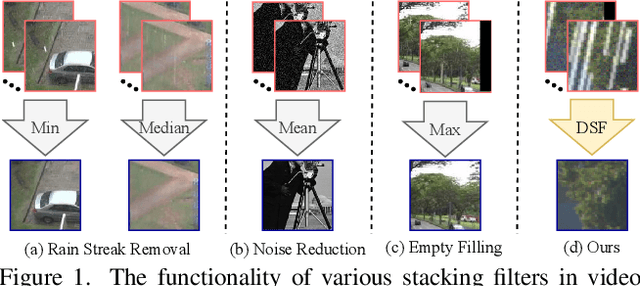

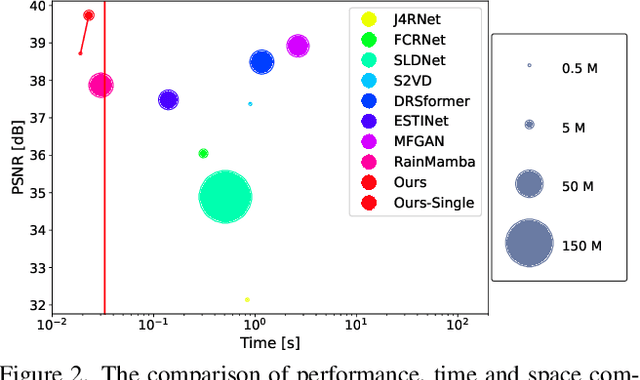
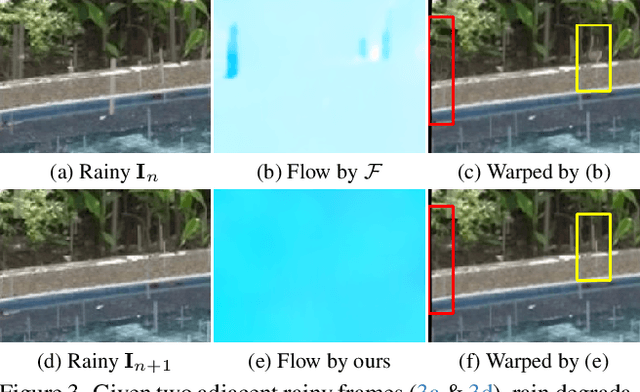
Abstract:Significant progress has been made in video restoration under rainy conditions over the past decade, largely propelled by advancements in deep learning. Nevertheless, existing methods that depend on paired data struggle to generalize effectively to real-world scenarios, primarily due to the disparity between synthetic and authentic rain effects. To address these limitations, we propose a dual-branch spatio-temporal state-space model to enhance rain streak removal in video sequences. Specifically, we design spatial and temporal state-space model layers to extract spatial features and incorporate temporal dependencies across frames, respectively. To improve multi-frame feature fusion, we derive a dynamic stacking filter, which adaptively approximates statistical filters for superior pixel-wise feature refinement. Moreover, we develop a median stacking loss to enable semi-supervised learning by generating pseudo-clean patches based on the sparsity prior of rain. To further explore the capacity of deraining models in supporting other vision-based tasks in rainy environments, we introduce a novel real-world benchmark focused on object detection and tracking in rainy conditions. Our method is extensively evaluated across multiple benchmarks containing numerous synthetic and real-world rainy videos, consistently demonstrating its superiority in quantitative metrics, visual quality, efficiency, and its utility for downstream tasks.
FaceInsight: A Multimodal Large Language Model for Face Perception
Apr 22, 2025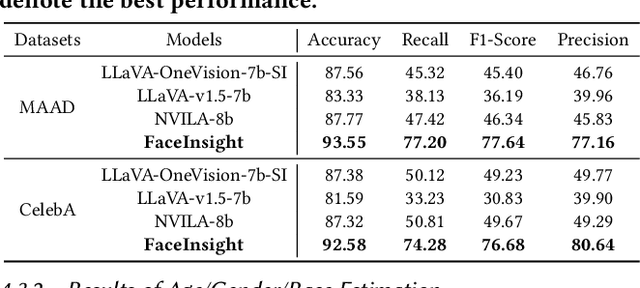
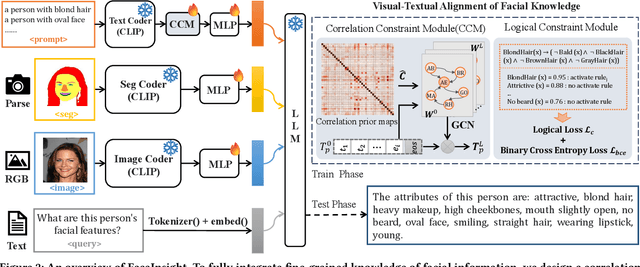
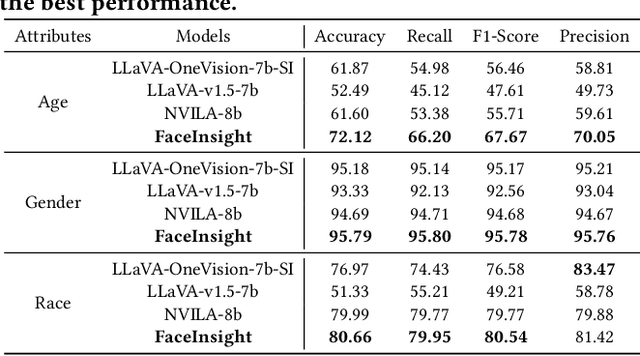
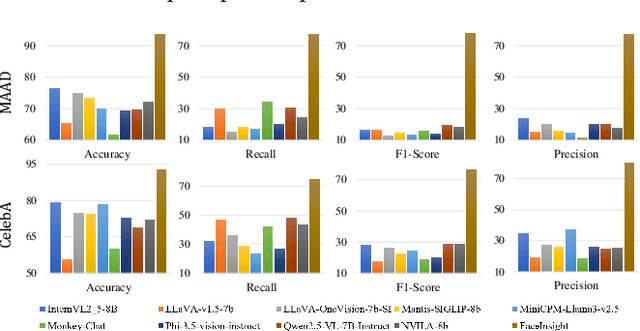
Abstract:Recent advances in multimodal large language models (MLLMs) have demonstrated strong capabilities in understanding general visual content. However, these general-domain MLLMs perform poorly in face perception tasks, often producing inaccurate or misleading responses to face-specific queries. To address this gap, we propose FaceInsight, the versatile face perception MLLM that provides fine-grained facial information. Our approach introduces visual-textual alignment of facial knowledge to model both uncertain dependencies and deterministic relationships among facial information, mitigating the limitations of language-driven reasoning. Additionally, we incorporate face segmentation maps as an auxiliary perceptual modality, enriching the visual input with localized structural cues to enhance semantic understanding. Comprehensive experiments and analyses across three face perception tasks demonstrate that FaceInsight consistently outperforms nine compared MLLMs under both training-free and fine-tuned settings.
UncTrack: Reliable Visual Object Tracking with Uncertainty-Aware Prototype Memory Network
Mar 17, 2025
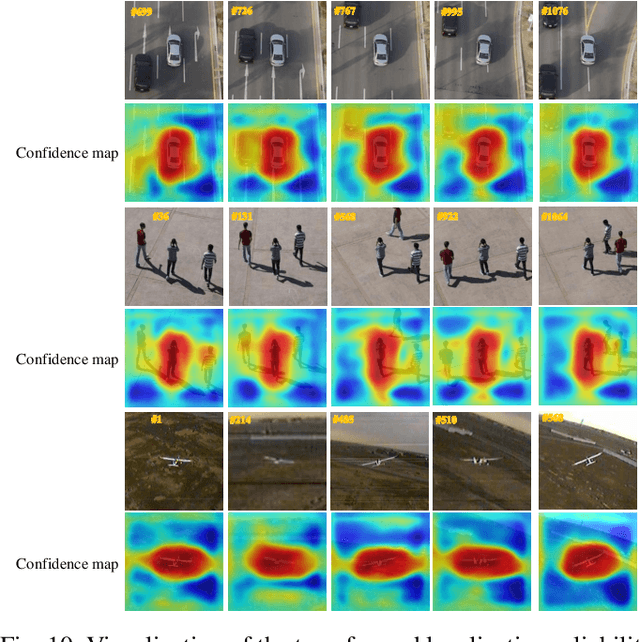

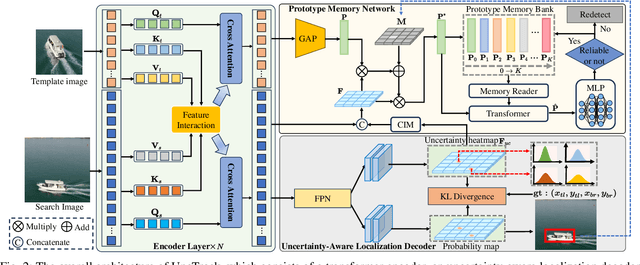
Abstract:Transformer-based trackers have achieved promising success and become the dominant tracking paradigm due to their accuracy and efficiency. Despite the substantial progress, most of the existing approaches tackle object tracking as a deterministic coordinate regression problem, while the target localization uncertainty has been greatly overlooked, which hampers trackers' ability to maintain reliable target state prediction in challenging scenarios. To address this issue, we propose UncTrack, a novel uncertainty-aware transformer tracker that predicts the target localization uncertainty and incorporates this uncertainty information for accurate target state inference. Specifically, UncTrack utilizes a transformer encoder to perform feature interaction between template and search images. The output features are passed into an uncertainty-aware localization decoder (ULD) to coarsely predict the corner-based localization and the corresponding localization uncertainty. Then the localization uncertainty is sent into a prototype memory network (PMN) to excavate valuable historical information to identify whether the target state prediction is reliable or not. To enhance the template representation, the samples with high confidence are fed back into the prototype memory bank for memory updating, making the tracker more robust to challenging appearance variations. Extensive experiments demonstrate that our method outperforms other state-of-the-art methods. Our code is available at https://github.com/ManOfStory/UncTrack.
Bringing RGB and IR Together: Hierarchical Multi-Modal Enhancement for Robust Transmission Line Detection
Jan 25, 2025Abstract:Ensuring a stable power supply in rural areas relies heavily on effective inspection of power equipment, particularly transmission lines (TLs). However, detecting TLs from aerial imagery can be challenging when dealing with misalignments between visible light (RGB) and infrared (IR) images, as well as mismatched high- and low-level features in convolutional networks. To address these limitations, we propose a novel Hierarchical Multi-Modal Enhancement Network (HMMEN) that integrates RGB and IR data for robust and accurate TL detection. Our method introduces two key components: (1) a Mutual Multi-Modal Enhanced Block (MMEB), which fuses and enhances hierarchical RGB and IR feature maps in a coarse-to-fine manner, and (2) a Feature Alignment Block (FAB) that corrects misalignments between decoder outputs and IR feature maps by leveraging deformable convolutions. We employ MobileNet-based encoders for both RGB and IR inputs to accommodate edge-computing constraints and reduce computational overhead. Experimental results on diverse weather and lighting conditionsfog, night, snow, and daytimedemonstrate the superiority and robustness of our approach compared to state-of-the-art methods, resulting in fewer false positives, enhanced boundary delineation, and better overall detection performance. This framework thus shows promise for practical large-scale power line inspections with unmanned aerial vehicles.
 Add to Chrome
Add to Chrome Add to Firefox
Add to Firefox Add to Edge
Add to Edge